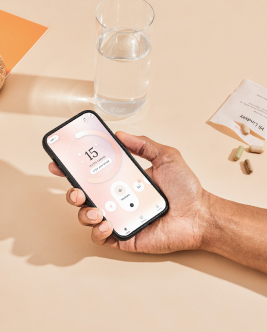nutrition
What Is the Difference Between a Fruit and a Vegetable?
On This Page

Do you really know the difference between a fruit and a vegetable? If so, can you identify them correctly? Find out here.
It may seem like a fairly silly question with an obvious answer, but it really isn’t. Without reading ahead, see if you can explain the difference between a fruit and a vegetable. It’s not as cut and dry as it may seem, and the answer isn’t always what you think it is. Even the Supreme Court once weighed in on the proper categorization of the tomato, fruit versus vegetable, circa 1893. They declared it a vegetable. But they were wrong. Just ask any botanist.
What are fruits?
Fruits are the mature, ripened ovaries that develop from the flower of a seed plant. One of the main functions of a fruit is to spread its fertilized seeds in order to generate new plants. All flowering plants produce fruit, whether it’s sweet tasting, sour, edible, or not. Fruits come from a variety of different types of plants; apples grow on trees, cranberries grow on low shrubs and vines, blueberries grow on shrubs, coconuts grow on trees, and pineapples grow from a leafy plant out of the ground.
What are the nutritional profiles of fruits?
Fruits are nutrient-rich, naturally low in fat, sodium, and calories, and an excellent source of many essential nutrients such as vitamins A and C, potassium, folate, and dietary fiber. They tend to have a higher amount of natural sugar and more calories when compared to most varieties of vegetables. The main source of calories in fruit is from carbohydrates, though both the calorie count and the carbohydrate content in fruit will vary according to the serving size and the type of fruit. The United States Department of Agriculture (USDA) recommends that every adult consume a minimum of 2-4 servings of whole fruit per day.
What is a vegetable?
Vegetables are the edible parts of the plants that are grown primarily for food. This can include the stalk (celery), the flower (cauliflower, broccoli), the leaves (spinach, kale), the root (carrots, garlic, sweet potatoes), the tuber (potatoes), and the shoots (asparagus, rhubarb). The USDA recommends that every adult consume a minimum of 3-5 servings of vegetables per day, and dark-green leafy vegetables several times each week.
What are the nutritional profiles of vegetables
Most vegetables have a water content of over 70 percent, making them naturally low in calories, fat, and sodium. They are nutrient-rich and good sources of minerals, especially calcium and iron, vitamins A and C, and folate. Vegetables generally contain fewer carbohydrates and sugar than fruits and are rich in dietary fiber and antioxidants.
Health benefits of fruits and vegetables
Fruits and vegetables are an essential part of a healthy diet. They are widely recommended for their health-promoting properties. They have high concentrations of vitamins, minerals, and electrolytes, and are also a good source of dietary fiber, which is essential for digestion and overall good health. The variety of colors of fruits and vegetables is evidence of the numerous phytochemical antioxidants in them. Phytochemicals are believed to help the body fight against disease and reduce the incidence of occurrence of disease. Metabolic activities of the human body are enhanced when vegetables are consumed in large quantities.
Differences in health benefits of fruits versus vegetables
While fruits and vegetables contain many similar vitamins and minerals, they have very different nutrient and phytochemical profiles. Many fruits and vegetables are high in vitamin C, which has been heralded for its antioxidant properties, while dark, leafy greens like spinach are the best sources of carotenoids necessary for healthy skin and brain aging. Other key phytochemicals such as glucosinolates are unique to cruciferous vegetables such as broccoli, cauliflower, and Brussel sprouts. Eating a mixture of fruits and vegetables is the best way to ensure that you are getting a wide variety of vitamins, minerals, and phytochemicals.
Highly mistaken fruits and vegetables
Not everything is as it appears to be in the world of fruits and vegetables. Some of the salad world’s most popular staples have been mislabeled for decades, if not longer. But now that the difference between fruits and vegetables is clear, it’s time to take a closer look at some of these fruits most people have long considered to be vegetables. And, yes, they are considered fruits. They all contain seeds, which is the hallmark of a fruit.
- Tomatoes (Despite what the US Supreme court ruled in 1893, this featured component of most salads is a fruit.)
- Winter squash
- Avocados
- Cucumbers
- Peppers
- Eggplant
- Olives
- Pumpkins
- Pea pods
- Zucchini
Final takeaways
Fruits and vegetables have a lot in common, not the least of which is the fact that everyone benefits from a diet rich in both of them. They are nutrient-dense, high in dietary fiber, and provide many essential vitamins, minerals, and antioxidants that facilitate health and wellness.
They are also low-calorie, low in fat, and provide all kinds of interesting flavors to delight your taste buds. It’s hard to imagine a culinary world without onions, olives, garlic, peppers, or any of one of the multitude of options available to enjoy for their flavor, texture, and health benefits.
Does it even matter if you know whether they’re vegetables or fruits? Is it essential to understand that fruits contain seeds, while vegetables can be the roots, stems, or leaves of the plant? Many people have lived long and prospered thinking that the tomato and the cucumber were vegetables.
What truly matters is that you eat the rainbow of colors in your meals. The CDC recommends 3-5 servings of vegetables and 2-4 servings of fruit daily. Most fruits and vegetables are largely low in fat, carbohydrates, and calories, and many can be eaten either raw or cooked. Some, like the apple or the banana, make quick, convenient, and healthy snacks. Others can be stored by canning, freezing, dehydrating, and blanching. All of them can be tossed into your blender at the same time for a healthy, nutritious, and, hopefully, delicious smoothie. And all of them are good for you. Just try to mix them up so you get the best that nature has to offer you.



